fuel OLDSMOBILE SILHOUETTE 1997 Owners Manual
[x] Cancel search | Manufacturer: OLDSMOBILE, Model Year: 1997, Model line: SILHOUETTE, Model: OLDSMOBILE SILHOUETTE 1997Pages: 436, PDF Size: 21.87 MB
Page 7 of 436
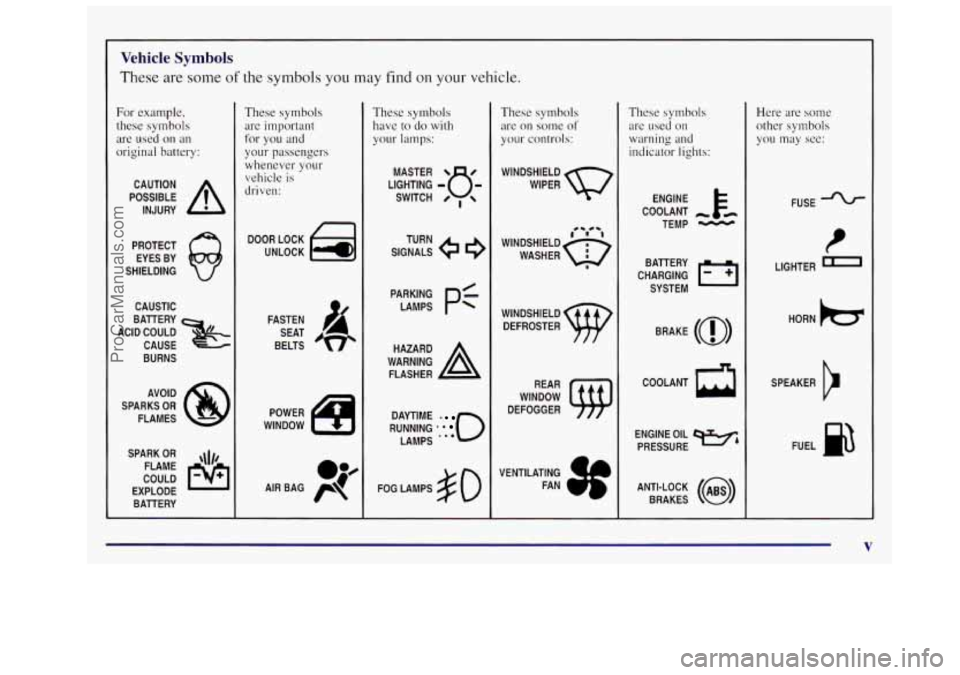
Vehicle Symbols
These are some of the symbols you may find on your vehicle.
For example,
these symbols
are used
on an
original battery:
POSSIBLE A
CAUTION
INJURY
PROTECT EYES BY
SHIELDING
CAUSTIC
ACID COULD
&
BATTERY
CAUSE
BURNS
AVOID
SPARKS
OR
FLAMES
SPARK
OR ,\I/,
COULD FLAME
EXPLODE BATTERY
These symbols are important
for you and
your passengers whenever your
vehicle is
driven:
DOOR LOCK
UNLOCK
FASTEN SEAT
BELTS
These symbols have
to do with
your lamps:
SIGNALS e
TURN
RUNNING
* ' 0
DAYTIME .
LAMPS .**
FOG LAMPS $0
These symbols
are
on some of
your controls:
WINDSHIELD
WIPER
WINDSHIELD DEFROSTER
WINDOW
DEFOGGER
VENTILATING FAN
These symbols are used
on
warning and
indicator lights:
COOLANT -
TEMP -
CHARGING 1'1
BATTERY
SYSTEM
BRAKE
(a)
COOLANT a
ENGINE OIL
PRESSURE
Wb
ANTI-LOCK (@)
BRAKES
Here are some
other symbols
you may see:
FUSE
P
LIGHTER -
HORN )tr
SPEAKER
b
FUEL B
ProCarManuals.com
Page 101 of 436

Instrument Panel Switchbank
This switchbank is located in the instrument panel below
the Comfort Controls. The switches and controls that
you may find
in this switchbank are the Rear Fan Knob,
Rear Window WiperNasher, Fog Lamps and Traction
Control.
If your vehicle does not have some of the
options controlled by these switches, there will
be a
blank button
in its place.
For more information, please see each
of these features
in the Index.
If your vehicle is not equipped with the Optional Rear
Climate Control system, there
will be a storage space in
this switchbank. The rubber mat can be removed for
cleaning. Snap the mat into place after cleaning.
Sliding Door
To open the sliding door from outside the vehicle, pull
the handle out and then pull the door toward
the rear. If
you slide the door all the way back, the door will rest in
a detent position. The door must overcome this detent
when closing.
To move the door forward, you must first pull the door
past
the open detent position.
Does your Oldsmobile have a sliding door on the left
side? If
it does, this door is designed to open only a little
if the fuel door is open. If this ever happens, don’t try to
force
the sliding door. Just close the left-side sliding
door. Then when the fuel filler door is closed, the
left-side sliding door can be opened normally.
2-13
ProCarManuals.com
Page 111 of 436

Content Theft-Deterrent (Option)
If your vehicle has this option, it has a theft-deterrent
alarm system.
A light located on top of your instrument panel (near the
center
of the vehicle, next to the windshield) will flash
slowly to let everyone
know that the system has
been armed.
While armed, the doors will not unlock
with the power
lock switch. Once armed,
the alarm will
go off if someone tries to
enter the vehicle (without using the key chain
transmitter or a key), breaks a window, tries
to damage
the vehicle or turns the ignition on. The horn will sound
and your vehicle’s park lamps will flash for up to
two
minutes. The system will also cut off the fuel supply,
preventing the vehicle from being driven.
When the alarm is armed, the liftgate may be opened
with the key chain transmitter or with a key.
Arming with the Power Lock Switch
Your alarm system will arm when you use either power
lock switch to lock
the doors while any door or the
liftgate is open and the key is removed from the ignition
(if you would like to turn off power lock switch arming,
see “Locks and Lighting Choices”
in the Index).
The security light flashes quickly to let you know when
the system
is ready to arm with the power door lock
switches. The security light will stop flashing and stay
011, when you press the rear of the power lock switch, to
let you know the system is arming. After all doors and
the liftgate are closed and locked, the security light will
begin flashing
at a very slow rate to let you know the
system is armed.
2-23
ProCarManuals.com
Page 117 of 436
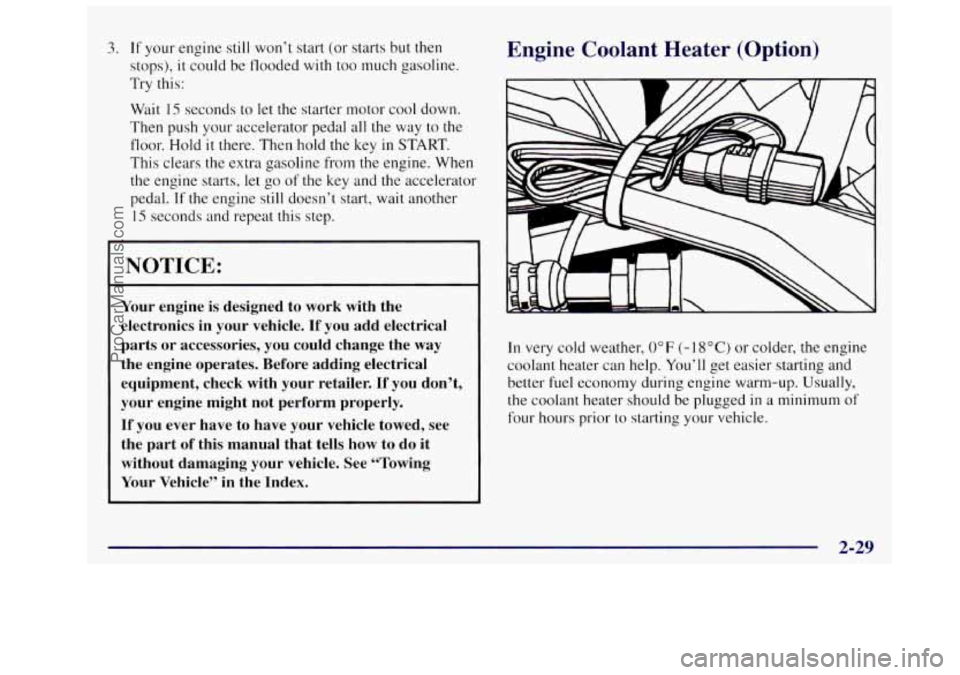
3. If your engine still won’t start (or starts but then
stops), it could be flooded with too much gasoline.
Try this:
Wait
15 seconds to let the starter motor cool down.
Then push your accelerator pedal
all the way to the
floor. Hold
it there. Then hold the key in START.
This clears the extra gasoline from
the engine. When
the engine starts,
let go of the key and the accelerator
pedal.
If the engine still doesn’t start, wait another
15 seconds and repeat this step.
NOTICE: I
Your engine is designed to work with the
electronics in your vehicle.
If you add electrical
parts or accessories, you could change the way
the engine operates. Before adding electrical
equipment, check with your retailer.
If you don’t,
your engine might not perform properly.
If you ever have to have your vehicle towed, see
the part of this manual that tells how to do it
without damaging
your vehicle. See “Towing
Your Vehicle” in the Index.
Engine Coolant Heater (Option)
In very cold weather, 0” F (- 18°C) or colder, the engine
coolant heater can help.
You’ll get easier starting and
better
fuel economy during engine warm-up. Usually,
the coolant heater should be plugged in a minimum of
four hours prior to starting your vehicle.
2-29
ProCarManuals.com
Page 121 of 436
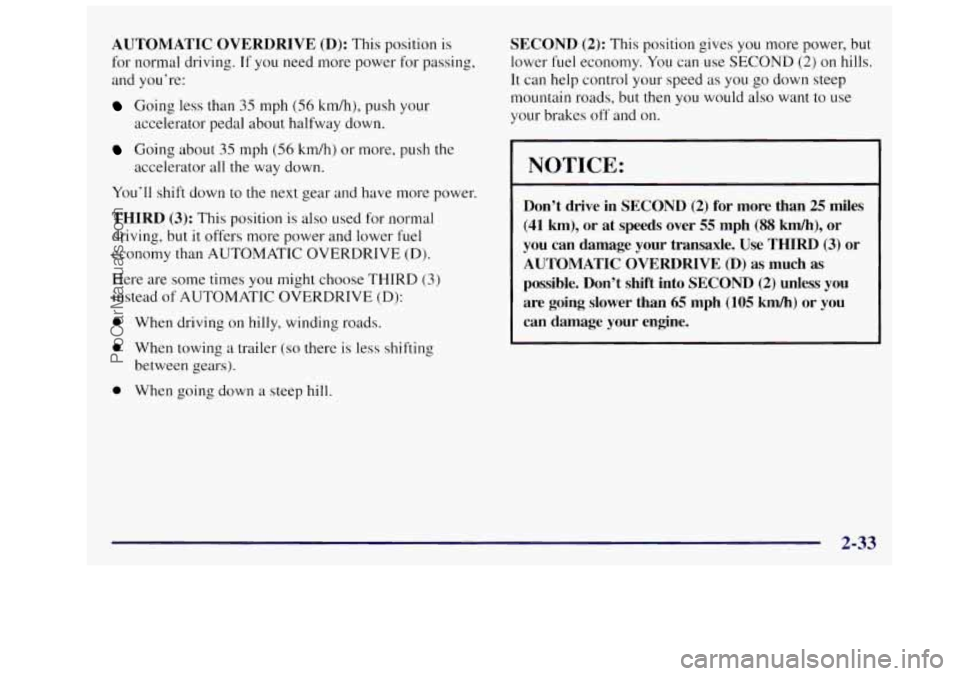
AUTOMATIC OVERDRIVE (D): This position is
for normal driving.
If you need more power for passing,
and you’re:
Going less than 35 mph (56 kdh), push your
Going about 35 mph (56 km/h) or more, push the
accelerator
pedal about halfway down.
accelerator
all the way down.
You’ll shift down to the
next gear and have more power.
THIRD (3): This position is also used for normal
driving, but
it offers more power and lower fuel
economy than AUTOMATIC OVERDRIVE (D).
Here are some times
you might choose THIRD (3)
instead of AUTOMATIC OVERDRIVE (D):
0 When driving on hilly, winding roads.
0 When towing a trailer (so there is less shifting
between gears).
0 When going down a steep hill.
SECOND (2): This position gives you more power, but
lower fuel economy. You can use SECOND
(2) on hills.
It can help control your speed as you go down steep
mountain roads, but then you would also want
to use
your brakes off and on.
NOTICE:
Don’t drive in SECOND (2) for more than 25 miles
(41 km), or at speeds over 55 mph (88 km/h), or
you can damage your transaxle. Use
THIRD (3) or
AUTOMATIC OVERDRIVE
(D) as much as
possible. Don’t shift into SECOND (2) unless you
are going slower than
65 mph (105 km/h) or you
can damage your engine.
2-33
ProCarManuals.com
Page 122 of 436
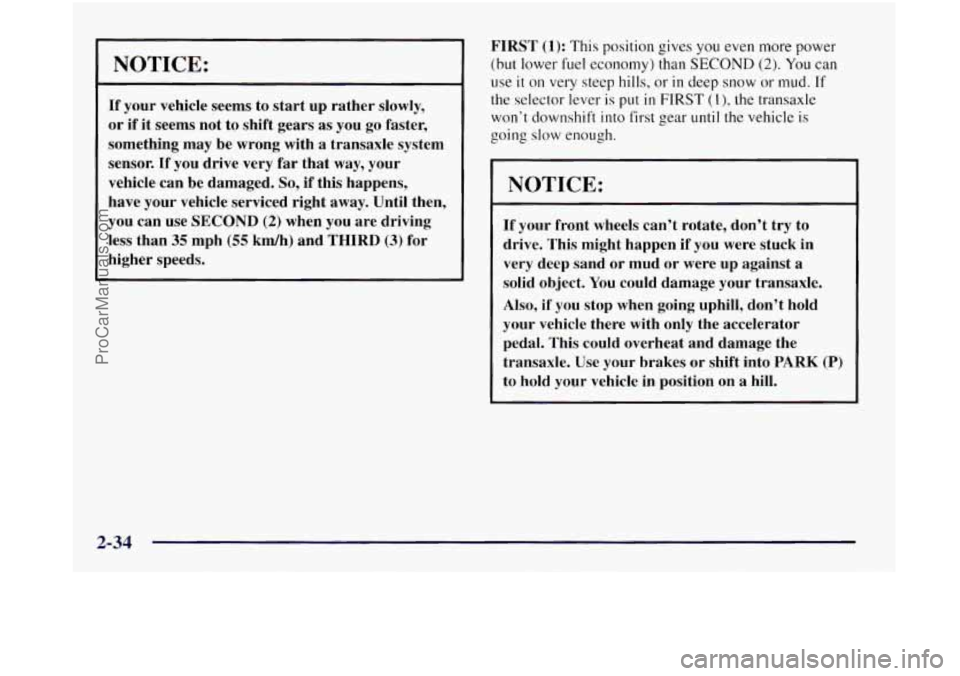
NOTICE:
If your vehicle seems to start up rather slowly,
or if it seems not to shift gears as you go faster,
something may be wrong with
a transaxle system
sensor.
If you drive very far that way, your
vehicle can be damaged.
So, if this happens,
have your vehicle serviced right
away. Until then,
you can use SECOND
(2) when you are driving
less than
35 mph (55 kmh) and THIRD (3) for
higher speeds.
FIRST (1): This position gives you even more power
(but lower fuel economy) than
SECOND (2). You can
use it on very steep hills, or in deep snow or mud. If
the selector lever is put in FIRST (I), the transaxle
won’t downshift into first gear
until the vehicle is
going
slow enough.
NOTICE:
If your front wheels can’t rotate, don’t try to
drive. This might happen if you were stuck in
very deep sand or mud or were up against
a
solid object. You could damage your transaxle.
Also, if you stop when going uphill, don’t hold
your vehicle there with only the accelerator
pedal. This could overheat and damage the
transaxle.
Use your brakes or shift into PARK (P)
to hold your vehicle in position on a hill.
2-34
ProCarManuals.com
Page 161 of 436

Automatic Compass Calibration
The compass is self-calibrating which eliminates the
need to manually set the compass. When the vehicle is
new,
the calibration process may not be complete. In
these cases the calibration symbol, C, will be displayed
where
the compass reading is normally displayed.
To calibrate the compass: In an area free from large metal
objects, make three
360" turns. The calibration symbol
will turn
off and the compass reading will be displayed.
Manual Compass Calibration
If the compass appears erratic and the calibration
symbol does not appear, you must manually put
the
compass into the calibration mode.
Turn the ignition on and cycle the DIC to the
CompadTernperature mode. Press both the E/M and
MODE buttons for at least
10 seconds until the
calibration symbol appears. Release both buttons and
complete three
360" turns in an area free from large
metal objects.
The calibration symbol will turn off and
the compass reading will be displayed.
Error Displays
An error of the vehicle's speed sensor or fuel sender
0 In the absence of vehicle communications, a double
will
cause
-E- to be displayed.
dash,
--, is displayed.
Trip Computer
There are five trip computer displays which may be
stepped through by pushing the MODE button. The
information will appear
in the following order:
0
0
0
0
0
Average Fuel Economy (AVG ECON) - This shows
the average fuel economy since the last reset.
Instantaneous Fuel Economy (INST ECON)
- This
shows fuel economy for the most recent second
of driving.
Trip Range (RANGE)
- This shows the estimated
distance that can be traveled with the remaining fuel.
The fuel economy used to calculate range is based on
the last few hours
of driving.
Trip Fuel Used (FUEL USED)
- This shows the
accumulated fuel used since the last reset.
Average Speed (AVG
SPEED) - This shows the
average speed since the last reset.
Resetting the Trip Computer
Press and hold the MODE and E/M buttons for at least
two seconds. The reset
is acknowledged with the display
showing all segments on for a period of half
a second. A
reset can only be done
in AVG ECON, FUEL USED
and AVG
SPEED displays. Resetting affects all three
displays regardless of what display you are in.
ProCarManuals.com
Page 177 of 436

Your instrument panel is designed to let you know at a glance how your vehicle is running. You’ll know how fast
you’re going, how much
fuel you’re using, and many other things you’ll need to drive safely and economically.
Refer to the accompanying diagram of your instrument panel
to locate the components listed below.
A. Side Vents
B. Front Vent
C. Turn SignaVMultifunction Lever
D. Hazard Warning Flashers Switch
E. Instrument Cluster
E Center Vents
G. Audio System
H. Side Vents
I. Lamps Switch
J. Hood Release
K. Steering Wheel Touch Controls (Option)
L. Horn
M. Ignition Switch
N. Steering Wheel Touch Controls (Option)
0. Climate Controls
P. Rear Fan Controls
Q. Accessory Power Outlet
R. Storage Bin
S. Remote CD Player (Option)
T. Instrument Panel Switchbank
U. LightedAshtray
V. Glove Box
W. Front Vents
X. Fuse Panel
2-89
ProCarManuals.com
Page 188 of 436
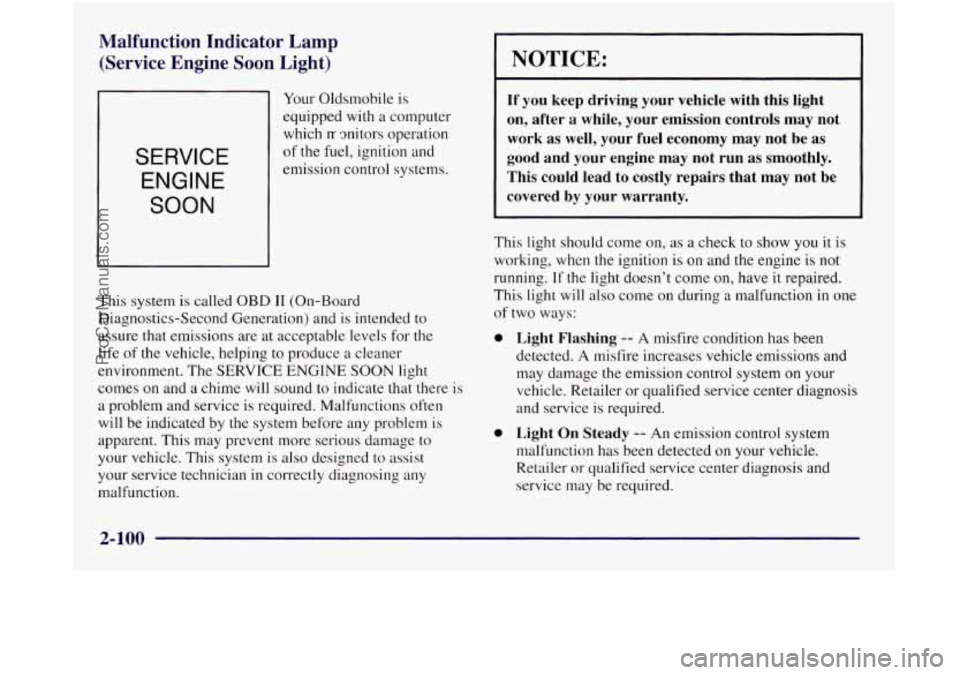
Malfunction Indicator Lamp
(Service Engine Soon Light)
SERVICE ENGINE
SOON
Your Oldsmobile is
equipped with a computer
which
rr mitors operation
of the fuel, ignition and
emission control systems.
This system is called
OBD I1 (On-Board
Diagnostics-Second Generation) and is intended to
assure that emissions are at acceptable levels for the
life
of the vehicle, helping to produce a cleaner
environment. The SERVICE ENGINE
SOON light
comes on and
a chime will sound to indicate that there is
a problem and service is required. Malfunctions often
will be indicated by
the system before any problem is
apparent. This may prevent more serious damage to
your vehicle. This system is also designed to assist
your service technician
in correctly diagnosing any
malfunction.
NOTICE:
If you keep driving your vehicle with this light
on, after a while, your emission controls may not
work as well, your fuel economy may not be as
good and your engine may not run as smoothly.
This could lead to costly repairs that may not be
covered by your warranty.
This light should come on, as a check to show you it is
working, when the ignition is on and the engine is not
running.
If the light doesn’t come on, have it repaired.
This light will also come on during
a malfunction in one
of two ways:
0
a
Light Flashing -- A misfire condition has been
detected. A misfire increases vehicle emissions and
may damage the emission control system on your
vehicle. Retailer or qualified service center diagnosis
and service is required.
Light On Steady -- An emission control system
malfunction has been detected
on your vehicle.
Retailer or qualified service center diagnosis and
service may be required.
2-100
ProCarManuals.com
Page 189 of 436
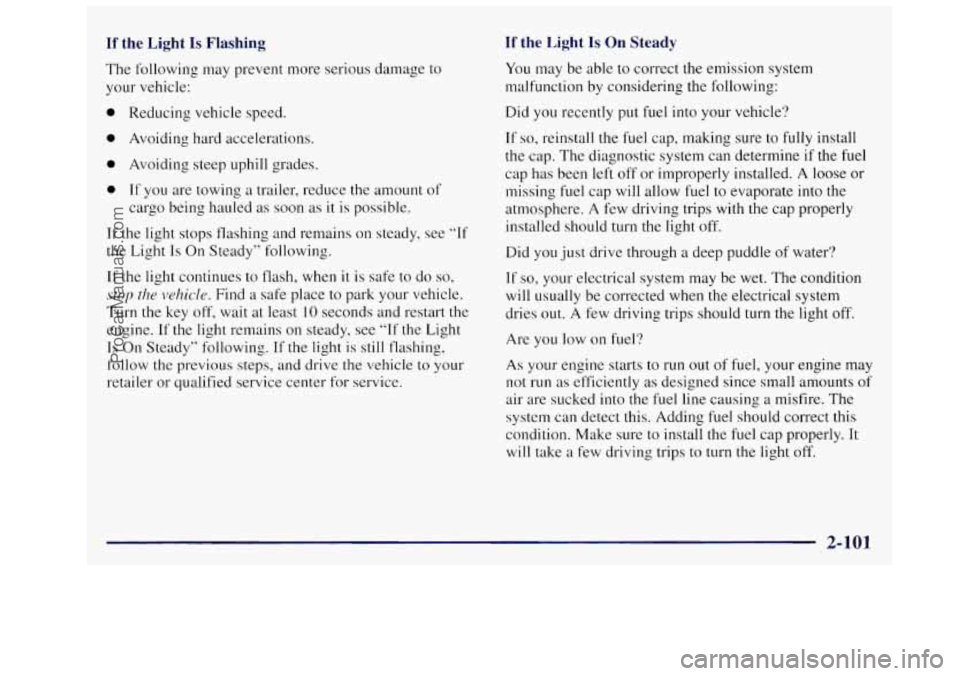
If the Light Is Flashing If the Light Is On Steady
The following may prevent more serious damage to
your vehicle:
0 Reducing vehicle speed.
0 Avoiding hard accelerations.
0 Avoiding steep uphill grades.
0 If you are towing a trailer, reduce the amount of
cargo being hauled as soon
as it is possible.
If the light stops flashing and remains on steady, see “If
the Light Is On Steady’’ following.
If the light continues to flash, when
it is safe to do so,
stop the vehicle. Find a safe place to park your vehicle.
Turn
the key off, wait at least 10 seconds and restart the
engine. If the light remains on steady, see
“If the Light
Is On Steady” following. If the light is still flashing,
follow the previous steps, and drive
the vehicle to your
retailer or qualified service center for service. You may be
able
to correct the emission system
malfunction by considering the following:
Did you recently put fuel into your vehicle?
If
so, reinstall the fuel cap, making sure to fully install
the cap. The diagnostic system can determine if the fuel
cap has been
left off or improperly installed. A loose or
missing fuel cap will allow fuel to evaporate into the
atmosphere. A few driving trips with the cap properly
installed should turn the light off.
Did you just drive through
a deep puddle of water?
IF so, your electrical system may be wet. The condition
will usually be corrected when the electrical system
dries out. A few driving trips should turn the light
off.
Are you low on fuel?
As your engine starts to run out of fuel, your engine may
not run as efficiently
as designed since small amounts of
air are sucked into the fuel line causing a misfire. The
system can detect this. Adding fuel should correct this
condition. Make sure to install the fuel cap properly. It
will take a few driving trips to turn the light off.
2-101
ProCarManuals.com